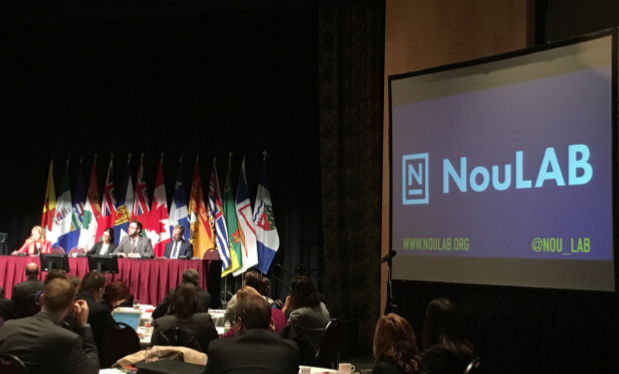OnOct. 13, 2016, the Clerks and Cabinet Secretaries came together for their second policy innovation conference. The theme of the event was “open policy-making in the digital age.”
Co-hosted by the Government of Canada and the Government of British Columbia, supported by the Public Policy Forum, this one-day session explored the topic through a mix of keynote and panel presentations drawing on perspectives from all sectors of the economy — public, private, NGO and academia — from Canada, the U.S. and the U.K. The purpose of this symposium was to bring diverse perspectives together in a dialogue around the co-creation of ideas, partnerships that create shared value and impact and making the policy process more open and diverse. A copy of the agenda is available in the appendices, along with the speaker biographies and a list of the participants.
The following report summarizes each of the presentations and panel discussions. A number of themes emerged during the keynote and panel presentations. Those dominant themes are explored in a companion discussion paper (available here).

Creating public value through partnerships in a digital age
Opening the day was James Anderson from Bloomberg Philanthropies, an international philanthropic organization that focuses its work at the cities and mayoral level to generate bold solutions that can be replicated around the globe. Through various programs, Bloomberg effects change to build capacity, to identify challenges and address solutions by opening up lines of dialogue and access to data. In his remarks, James Anderson emphasized that access to data enables front-line workers to identify challenges, promote the cross-pollination of ideas and deliver solutions, supporting these statements with compelling examples of change from South America, India, and the United Kingdom. Each demonstrated how governments can create space for citizens to engage in city-making, often by providing tools and information then opening the discussion and decision process to citizen voices. This can generate novel solutions, tailored to the needs of communities, that are seen are fair and legitimate by citizens.
Rebooting the policy-making process: jurisdictional strategies to re-engage Canadians
Panelists from the Government of Canada, New Brunswick and Ontario presented three different approaches to revitalizing public engagement, as a component of the policy-making process. Christiane Fox, Assistant Secretary to the Cabinet, noted the Government of Canada has a long history of public engagement. In recent years, the engagement process has become more and more diverse across an increasing number of departments. The Privy Council Office is developing a centre of expertise that any department or agency can leverage in their own respective consultation processes to ensure valuable, constructive results and a quality and accessible experience for Canadians. In doing so, the Privy Council Office supports the work of all departments to ensure effective engagement strategies without being prescriptive about the work of other departments and agencies.
The New Brunswick Social Policy Research Network (SPRN) operates on a three-part network model. The SPRN engages the New Brunswick Executive Council office to identify public policy challenges to be addressed, and co-develop a map of those challenges. Staff regularly consult citizens of the province to discuss challenges identified by the government, to discuss solutions to those challenges, and to identify additional challenges at the grassroots level. SPRN staff also seek out and develop partnerships with civil society and expert groups — in New Brunswick and around the world — who possess complementary areas of expertise to the SPRN team as part of the process to identify solutions and introduce new methods of engagement. The SPRN model is iterative and ever-greening. It promotes a commitment to consultation and engagement as a part of the policy making process, and enables views of citizens to directly inform government policy priorities.
The Ontario Cabinet Office recently launched an initiative to create networks around emerging policy issues, including those which cut across multiple ministries. For example, the Ontario government now has an internal network to explore policy issues related to autonomous vehicles. Membership in the network is open to all public servants, and participation is voluntary. The cross-departmental nature of the network is predicated on the notion that individuals with a personal or professional interest in this issue will join the network, contribute to discussions and share information in a dis-intermediated, non-hierarchical way. Information shared through the network will seek to break down silos between departments and agencies, and could also be used to inform official advice to government.
Harnessing non-governmental platforms for public good
Jennifer Hollett, Head of News and Government, Twitter Canada and Amanda Clarke, Assistant Professor, Carleton University presented two perspectives on the use of digital platforms for public good. Jennifer Hollett discussed how Twitter has changed the way in which news is generated and disseminated. Twitter has given civil society direct access to elected officials and news makers, and in many ways, bypassed the traditional media gate keepers, creating competition for those media outlets. Individuals can search out or choose their news (by building lists of people to follow or using hashtags), not just listen the pre-approved list of stories that appear at the top of the hour on radio or television. Jennifer shared examples of movements that have gone viral through the use of Twitter.
Dr. Clarke’s presentation focused on the concept of government as a platform: rather than government always implementing policies and programs, they can choose instead to create the conditions and legal environment for other organizations to create public value. This often materializes in public, private and NGO sectors working together in a network. She summarized key findings of networked approaches from the 1980s and 1990s. Recognizing that much of the early activity focused on service delivery, Dr. Clarke presented some thoughtful context for how platform thinking in the space of service delivery can inform the same in policy work. Dr. Clarke encouraged the public sector to carefully consider and design partnerships to minimize risk and maximize the benefit for all partners and users. Culture matters, and cannot be underestimated. By their nature, each sector — whether private, public, academic or NGO — operates according to different motivations. Each stakeholder will engage in a partnership to meet different goals; a partner in one sector cannot assume that a partner from another sector will organically identify and solve the exact same challenge. As such, effective partnerships must be carefully negotiated — from choice of partners, to choice of technology, to clearly defined roles and responsibilities for each partners, to who owns the data that is generated and remuneration for the partnership — in order to ensure an effective outcome for the intended audience.
Innovation in Service Delivery — Global Best Practices and the Potential of Social Enterprises
Social enterprises are for-profit or non-profit organizations that use business strategies to achieve a social or environmental impact.
While generating revenues from the sale of goods and services, they also expressly intend to create positive outcomes and they measure their results. As their business grows, their social impact grows. Jurisdictions like the province of Ontario are beginning to encourage the growth of social enterprises for their ability to tackle tough social and environmental challenges in a financially sustainable manner, and for their ability to attract private investment capital and translate it into social and environmental solutions.
In 2016, the Government of Ontario launched its social enterprise strategy. This strategy, as described by Giles Gherson, Deputy Minister of Economic Development and Growth with the Government of Ontario, extends current business growth initiatives to social enterprises in ways that recognize the social mandate of the individual organizations. Now, social enterprises in Ontario can secure government support to financing, to attract other (e.g. venture capital) funds, identify clients and markets (through procurement and access to new markets), and measure impact in non-traditional ways.
Mr. Gherson’s presentation was illustrated with case studies from three social enterprises. Dr. Guy Turnbull, Managing Director of CASA Ltd, Dai Powell, CEO of the HCT Group (both of the United Kingdom), and Marcia Nozick, Executive Director, EMBERS Staffing Solutions (in Vancouver) presented an overview of their respective organizations. Each identified the social challenge their organization was created to address — public transportation, affordable home health care, and employment services, respectively — and the barriers they faced in building these enterprises.
Facilitated Session — Collaboration: What can be done together?
In the final conference session, six panelists — Amanda Clarke, Assistant Professor, Carleton University; Elizabeth Dubois, Assistant Professor, University of Ottawa; Don Lenihan, Senior Associate, Policy and Engagement, Canada 2020; Colin McKay, Head of Public Policy and Government Relations, Google Canada; Parker Mitchell, Entrepreneur; and Taylor Owen, Assistant Professor, University of British Columbia — offered their insights on the topic and themes of the day. Following those initial comments, moderators Alison Loat and Ed Greenspon facilitated a conversation with the panelists, and then with the audience. What follows is a summary of the points raised during the last session.

Open policy is not (always) digital. Open policy and digital policy are linked and can be complementary, but they are not interchangeable. Many panelists pointed to the conversations that took place throughout the day on one topic or the other, noting that open and digital have different opportunities and implications for the policy making process. For example, digital technology can simply be the channel for consultation in a largely traditional policy making process. Open policy tends to refer to the idea that governments should increasingly open the black box around the Westminster parliamentary policy making system and seek input and collaboration from more voices. Panelists asked government policy makers to think about both of these concepts, and how each or both will contribute to (a) policy goal(s). In the context of the Westminster system, how much decision making authority is government willing to turn over to the public?
Negotiating partnerships and incentives. Each sector of the economy — public, private, NGO and academic — operates according to a different set of incentives. This variation in incentive structure can create conflict during partnerships and network approaches to working if not first addressed in the early stages of a project, and result in asymmetrical risk-reward relationships amongst partners. Government as a platform requires government to both leverage the platforms that people use and to govern behavior in those platforms. To do this effectively, partnerships with other organizations must be clearly and comprehensively outlined in such a way as to identify roles and responsibilities in many different scenarios, and also to reward partners according to the incentive structures to which they are designed to respond. In addition, the attributes of a digital world — including high risk tolerance, rapid iteration of ideas, and decentralized organization — are incongruous with the structure of government institutions. This can create tensions for government who enter into them if they are not prepared to transition to more open dialogue with citizens, including the conflicts, tradeoffs, and general messiness that broad participation can entail, though it can lead to better, more informed policy choices.
The benefits of scale. Several panelists remarked on the vast number and type of consultations underway at the federal and provincial levels of government, noting the benefits to sharing data and good ideas across departments and between orders of government. However, panelists were divided on the importance of a consistent process for consultation. One panelist suggested consistency is important to ensure findings are comparable. Another panelist suggested that focusing on comparability could result in a ‘cookie-cutter’ consultation process that ignores the unique challenges of certain policy questions.
Context is important. Digital tools are useful for analyzing vast amounts of data to identify trends and outliers. However, they are still only as good as the people using them: people may digitize algorithm biases and not consider the social, cultural, economic or political context in which the challenge, barrier or opportunity exists. Policy development also requires creative, human brains to think about the challenge (and what the data suggests) in real-world contexts. Policy makers who use digital tools should be aware of the limitations of digital tools and understand how to overcome those limitations.
Citizen engagement and expectation. Does government face the same disruptive threat as other sectors of the economy? Two panelists suggested not. Those panelists also noted that faith in public institutions is at an all-time low and suggested that because the erosion of public confidence has occurred at such a slow pace, the defining moment of the crisis is difficult or impossible to pinpoint. They concluded that government faces two challenges: a) to improve trust and confidence of Canadians in public institutions, and b) to marshal an all-of-government response to an issue that has no clear defining moment.
Closing remarks and next steps
Michael Wernick, Clerk, Privy Council Office, and Kim Henderson, Cabinet Secretary of the Government of British Columbia provided closing remarks at the symposium indicating the ongoing commitment of federal, provincial, and territorial governments to advance collective efforts in improving open policy making approaches across Canada.








